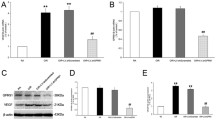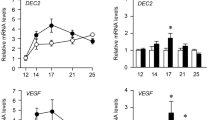Abstract
Objective
To investigate the influence of Estradial (E2) at physiological concentration on mRNA expression of vascular endothelial growth factor (VEGF) and hypoxia-inducible factor-1α(HIF-α1) in bovine retinal vascular endothelial cells (BRECs) under different oxygen conditions.
Methods
The mRNA expression of VEGF, HIF-1α in BRECs was studied by quantitative reverse-transcription PCR (qRT-PCR), and protein levels were assayed by Western Blot. Different concentrations of E2 (10−12, 10−10, 10−8 mol/l) and estrogen receptor antagonist Tamoxifen (10−7 mol/l) were added into the cell culture medium of different groups, while the phosphate-buffered saline (PBS) was added in the control group instead. Culture conditions were set to be under normoxia and hypoxia. The results of each group were detected after 8 hours and 24 hours.
Results
(1) Under hypoxia, gene expression of VEGF, HIF-1α in BRECs increased more than that of the control group (P < 0.05). There is evident positive correlation between the mRNA and protein levels of VEGF and HIF-1α (r = 0.82). (2) Treated with 10–8 mol/l E2, the expression of VEGF mRNA was increased in a time–dependent manner (P < 0.05). Treated with the indicated to concentrations of E2 (10− 12 ∼ − 8 mol/l) under normoxia for twenty-four hours, the mRNA expression of VEGF in BRECs was increased in a dose–dependent manner (P < 0.05), whereas E2 did not influence the mRNA expression of HIF-1α (P > 0.05). (3) Under hypoxia , E2 reduced the mRNA and protein levels of HIF-1α and VEGF in a concentration-dependent manner (P < 0.05), and the decrease developed in a time-dependent manner (P < 0.05). (4) An overdose of tamoxifen (10−7 mol/l) reversed the effect of E2 (10−8 mol/l) (P < 0.05).
Conclusions
E2 increases the gene expression of VEGF in BRECs under normoxia, whereas E2 reduces the gene expression of VEGF in BRECs through HIF-1α under hypoxic conditions in a dose-dependent and time-dependent manner. The contrasting effect of E2 on mRNA expression of VEGF may play a prophylactic role in retinopathy of prematurity (ROP).






Similar content being viewed by others
References
Suzuma I, Mandai M, Takagi H, Suzuma K, Otani A, Oh H, Kobayashi K, Honda Y (1999) 17 Beta-estradiol increases VEGF receptor-2 and promotes DNA synthesis in retinal microvascular endothelial cells. Invest Ophthalmol Vis Sci 40:2122–2129
King GL, Goodman AD, Buzney S, Moses A, Kahn CR (1985) Receptors and growth-promoting effects of insulin and insulin-like growth factors on cells from bovine retinal capillaries and aorta. J Clin Invest 75(3):1028–1036
Aiello LP, Northrup JM, Keyt BA, Takagi H, Iwamoto MA (1995) Hypoxic regulation of vascular endothelial growth factor in retinal cells. Arch Ophthalmol 113(12):1538–1544
Yamagishi S, Kawakami T, Fujimori H, Yonekura H, Tanaka N, Yamamoto Y, Urayama H, Watanabe Y, Yamamoto H (1999) Insulin stimulates the growth and tube formation of human microvascular endothelial cells through autocrine vascular endothelial growth factor. Microvasc Res 57(3):329–339
Distler O, Scheid A, Del Rosso A, Rethage J, Neidhart M, Gay RE, Müller-Ladner U, Gassmann M, Matucci-Cerinic M, Gay S (2002) HIF-1 mediated upregulation of VEGF and VEGF-R in systemic sclerosis (SSc): Imbalance with angiostatic factors suggestsVEGF as a novel option for the treatment of ischemia in patients with SSc. Arthritis Res 4(Suppl 1):1
Miyamoto N, Mandai M, Takagi H, Suzuma I, Suzuma K, Koyama S, Otani A, Oh H, Honda Y (2002) Contrasting effect of estrogen on VEGF induction under different oxygen status and its role in murine ROP. Invest Ophthalmol Vis Sci 43(6):2007–2014
Forsythe JA, Jiang BH, Iyer NV, Agani F, Leung SW, Koos RD, Semenza GL (1996) Activation of vascular endothelial growth factor gene transcription by hypoxia-inducible factor 1. Mol Cell Biol 16(9):4604–4613
McLaren J, Prentice A, Charnock-Jones DS, Millican SA, Müller KH, Sharkey AM, Smith SK (1996) Vascular endothelial growth factor is produced by peritoneal fluid macrophages in endometriosis and is regulated by ovarian steroids. J Clin Invest 98(2):482–489
Acknowledgments
The present study was conducted thanks to the staff of the central laboratory of Shandong Provincial Hospital for cell culture assistance.
Author information
Authors and Affiliations
Corresponding author
Additional information
There is no financial relationship with the origination that sponsored our research. We certify that we have full control of all primary data and agree to allow Graefes Archive for Clinical and Experimental Ophthalmology to review our data upon request.
Rights and permissions
About this article
Cite this article
Ma, X., Bi, H., Qu, Y. et al. The contrasting effect of estrogen on mRNA expression of VEGF in bovine retinal vascular endothelial cells under different oxygen conditions. Graefes Arch Clin Exp Ophthalmol 249, 871–877 (2011). https://doi.org/10.1007/s00417-010-1594-4
Received:
Revised:
Accepted:
Published:
Issue Date:
DOI: https://doi.org/10.1007/s00417-010-1594-4




